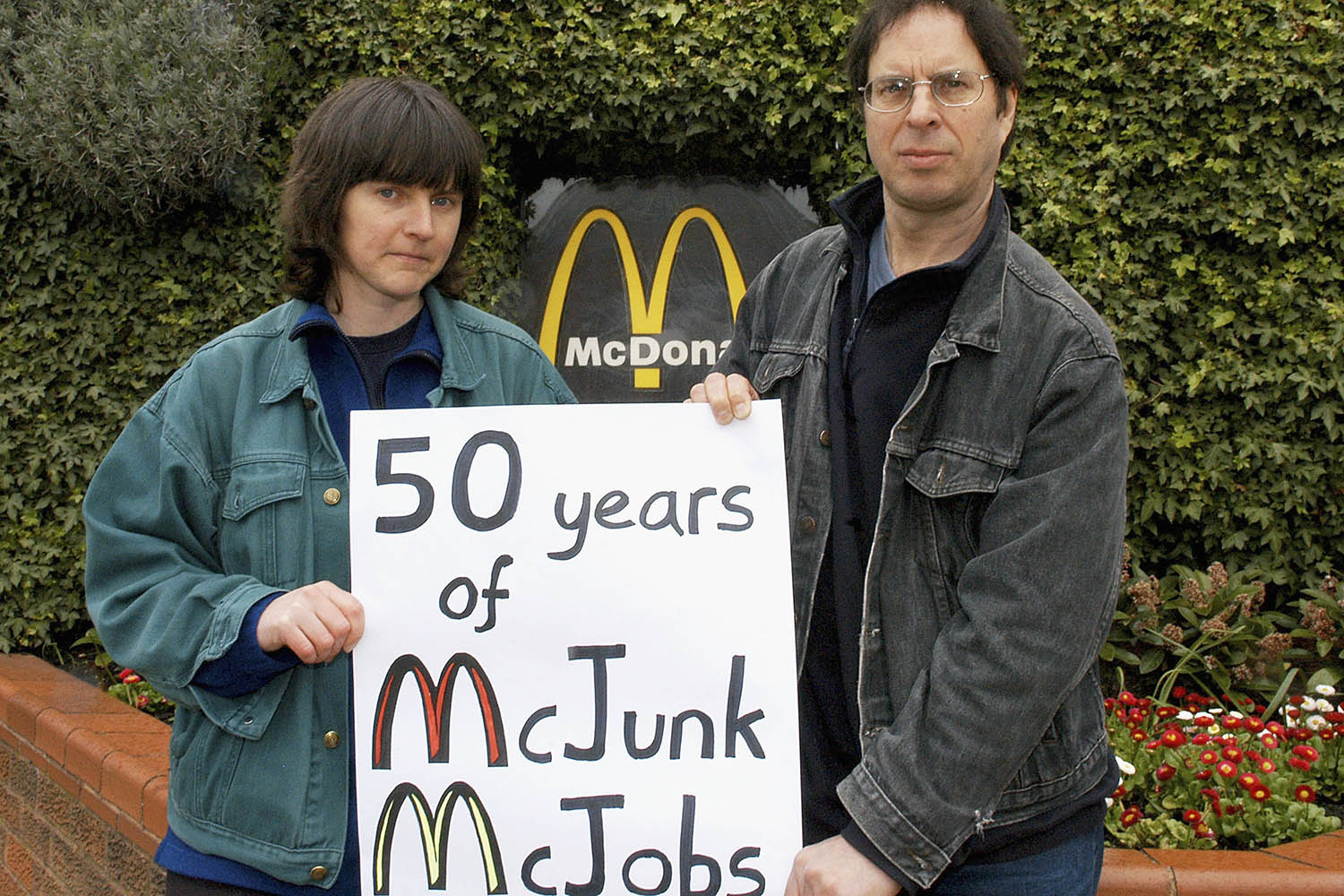This week, three BBC shows about Britain’s past, exploring colonialism, council estates, Robert Kilroy-Silk, paedophile hunting, McDonald’s baiting, second world war shame… oh and so much more. What a country we are!
Let’s begin in the good old 90s, with a couple of stubborn lefties and an anti-Maccy D’s leaflet. In The People vs McDonald’s, the energetic and funny Mark Steel talks to said lefties, Dave Morris and Helen Steel, about going up in court against one of the biggest corporations in the world. In 1990, Morris and Steel were served with a writ by McDonald’s for libel because – along with others from London Greenpeace – they’d handed out a few hundred handbills entitled “What’s wrong with McDonald’s?” outside an actual McDonald’s. Their leaflet asked readers to consider the company’s dubious track record on subjects such as animal husbandry, rain forest destruction, the nutritional content of its produce, and whether or not it deliberately marketed to children. Controversial? McDonald’s thought so. As there was no legal aid for libel cases, Morris and Steel represented themselves in court. The “McLibel” case became the longest in British trial history, lasting from the pre-trial shenanigans in 1994 right up until the judge’s 762-page judgment in 1997.
The series reminded me that, like many journalists at the time, I went along to the McLibel trial for a day. It wasn’t thrilling – I remember Morris shuffling a lot of papers and saying “erm” a lot – but this series is riveting. Helen Steel, in particular, is hugely impressive; not in an egotistical way, but because of her refusal to back down. One opposition lawyer describes her as a loss to the legal industry. And her story is even more gripping because her boyfriend at the time, a genial fellow activist known as New Zealand John, turns out to be an undercover policeman. (Anyone who listened to the excellent Bed of Lies would now recognise John’s MO: the van and the lack of backstory are giveaways.) Anyway, when New Zealand John disappears while Steel is in the middle of the McLibel case, she is genuinely bereft. She can’t work out what’s happened, and, alongside all the work she’s doing for the trial, she does a lot of digging to try to find out where –and indeed who – John is.
I remember thinking of her and Morris as idealistic hippies. More fool me. Now, rightly, they’re celebrated as hardcore heroes
A few years later – and you find yourself muttering “Go Helen!” when this happens – Steel flies to New Zealand and confronts John at an airport. God, the woman lives up to her name. I remember thinking of her and Morris as idealistic hippies. More fool me. Now, rightly, they’re celebrated as hardcore heroes, and this series shows exactly why.
A more flawed and complicated heroine takes centre stage in The Ballad of Big Mags, which offers a look at another 90s figure and what she stood up against. Myles Bonnar, who made the excellent Dead Man Running, is on top form once more as our host and investigator. His accurate description of the vociferous, attention-grabbing “Big Mags” rang bells, and when he mentioned her appearance on the TV show Kilroy, I remembered her: a peroxide-topped rocket of a woman; you definitely wouldn’t mess.
Margaret “Big Mags” Haney was the self-designated leader of the Raploch council estate in Stirling, and first gained attention when she led a group of fellow Raplochers in turfing out a convicted paedophile who had been housed on the estate. She went on to help others “encourage” child abusers to move away from the area and swiftly became a TV and tabloid sensation. Bonnar discovers that Mags used her strange star quality to assist other people, too, like journalists and, shockingly, the police (despite snitching being hugely frowned upon in the community). By the second episode, Mags puts you in mind of a mob boss, and by the third we discover that, yes, that’s not far off. Her family connections are heavy. If you step back a little, you could well think that Big Mags wasn’t actually all that big, and wonder whether she’s worthy of a six-part series – but Bonnar’s lively presentation keeps you coming back for more.
Finally, we go much further back, to the Asian front of the second world war, for The Second Map. The exemplary, dedicated, details-driven journalist Kavita Puri (she made the brilliant Three Million, about the Bengal famine of 1943) takes us to Singapore, Burma (now Myanmar), Japan and India to uncover the stories of a wildly varied selection of people. We meet Maurice Naylor, a British soldier who was wrongly told by his commander that the Japanese would be pushovers: “They’re very poorly equipped, they can’t see at night, they wear rubber plimsolls and they often go around on bicycles.” Also Yavar Abbas, a 104-year-old Indian veteran who took the complicated choice to fight for the British against the Japanese, even though he wanted Indian independence from Britain. And the “Jungle Queen”, Ursula Bower, a north London woman turned guerilla fighter against the Japanese.
Puri is such a wonderful, old-school journalist: a sensitive interviewer, a thorough investigator, a clear presenter. These stories, though not entirely buried, have been ignored for many years, because, as The Second Map makes clear, they don’t sit well with the idea of Britain as “winning” the war without ever being invaded (when the Japanese conquered parts of the British empire, people were genuinely shocked). Puri’s dedication is admirable. This series should not be missed.
Photograph by Getty Images

